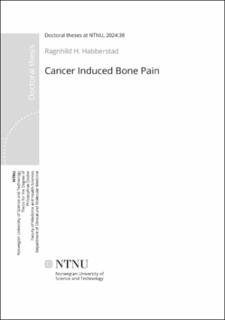| dc.contributor.advisor | Klepstad, Pål | |
| dc.contributor.advisor | Lund, Jo-Åsmund | |
| dc.contributor.advisor | Kaasa, Stein | |
| dc.contributor.advisor | Caraceni, Augusto | |
| dc.contributor.author | Habberstad, Ragnhild | |
| dc.date.accessioned | 2024-01-23T15:05:25Z | |
| dc.date.available | 2024-01-23T15:05:25Z | |
| dc.date.issued | 2024 | |
| dc.identifier.isbn | 978-82-326-7677-4 | |
| dc.identifier.issn | 2703-8084 | |
| dc.identifier.uri | https://hdl.handle.net/11250/3113397 | |
| dc.description.abstract | Bone metastases causing cancer induced bone pain (CIBP) is one of the most frequent reasons for pain in patients with cancer. Although pain is a common consequence of bone metastases, not all patients with bone metastases experience pain. There is limited knowledge to explain why some patients with bone metastases develop CIBP or if there are factors that could be helpful to predict pain severity in these patients. Radiotherapy (RT) can reduce CIBP. Modulation of a local inflammatory response is proposed to contribute to the analgesic effect from RT. Of patients undergoing RT for CIBP, about half of the patients experience a significant pain reduction after treatment. As RT can cause side effects, and for some patients involve a long travelling distance and admittance to hospital, it would be beneficial to avoid RT in patients with no treatment response. Little is known about which patients that are more likely to respond to RT, and many patients undergo RT without a clinical benefit.
This PhD project includes three papers from two international and longitudinal multicenter studies. In the European Palliative Care Cancer Symptom (EPCCS) study, we performed a subgroup analysis of 606 cancer patients with bone metastases that were followed approximately every month in one year or until withdrawal or death. The aim of the study was to explore if pain characteristics and other clinical factors were associated with ongoing and future pain intensity in patients with bone metastases. In paper 1 we found that patients with higher current pain intensity, sleep disturbances, drowsiness, male gender and episodic pain exacerbations had significantly higher pain intensity at the next follow-up in one month and higher average pain intensity the last 24 hours. The identified factors cannot alone be used to predict CIBP, but can identify patients with bone metastases that could benefit from more frequent follow-up or pain-relieving interventions like RT. The findings could also contribute to better understanding of CIBP towards more personalized cancer pain treatment.
In the Palliative Radiotherapy And Inflammation Study (PRAIS), we included 574 patients about to undergo palliative RT due to CIBP. We wanted to investigate if clinical variables and inflammatory markers could predict RT treatment efficacy in patients with CIBP from bone metastases.
In paper 2 we found that better performance status, breast or prostate cancer and presence of soft tissue expansion outside bone predicted RT response in patients with painful bone metastases. Patients using corticosteroids had significantly lower response rates. There was no difference in RT response in patients receiving single fraction RT compared to multiple fraction RT. A clinical index to reliably select patients that would benefit from palliative RT due to painful bone metastases could not be developed based on our findings due to a moderate discriminative ability of the model. Each of the significant variables identified in the study should be individually considered, together with other relevant factors, to decide if the patient is a suitable candidate for RT.
In paper 3 we found that none of the investigated inflammatory markers measured before the start of RT could select patients with a higher likelihood of analgesic RT response from CIBP, but the change in several inflammatory markers 3 weeks after RT was associated with RT response. A three-week change in the inflammatory makers IL-8, IP-10, eotaxin, MCP-1, G-CSF and TNF were positively associated with RT response, while a three-week change in CRP was negatively associated with RT response. These findings could indicate that inflammation is an important component to initiate an analgesic RT response in patients with painful bone metastases, although the inflammatory markers could not be used to select patients suitable for RT prior to treatment. The association between RT and change in inflammatory markers after RT could point towards inflammation as a potential future treatment target for patients with painful bone metastases. | en_US |
| dc.language.iso | eng | en_US |
| dc.publisher | NTNU | en_US |
| dc.relation.ispartofseries | Doctoral theses at NTNU;2024:38 | |
| dc.relation.haspart | Paper 1: Habberstad, Ragnhild H; Hjermstad, Marianne Jensen; Brunelli, Cinzia; Kaasa, Stein; Bennett, Michael I; Pardon, Koen; Klepstad, Pål. Which factors can aid clinicians to identify a risk of pain during the following month in patients with bone metastases? A longitudinal analyses. Supportive Care in Cancer 2019 ;Volum 27.(4) s. 1335-1343. Copyright © 2019 Springer. Available at: http://dx.doi.org/10.1007/s00520-018-4405-9 | en_US |
| dc.relation.haspart | Paper 2: Habberstad, Ragnhild H; Frøseth, Trude Camilla Salvesen; Aass, Nina Kathrine; Bjerkeset, Ellen; Abramova, Tatiana Mikhailovna; Garcia-Alonso, Elena; Caputo, Mariangela; Rossi, Romina; Boland, Jason W.; Brunelli, Cinzia; Lund, Jo-Åsmund; Kaasa, Stein; Klepstad, Pål. Clinical Predictors for Analgesic Response to Radiotherapy in Patients with Painful Bone Metastases. Journal of Pain and Symptom Management 2021 ;Volum 62.(4) s. 681-690. © 2021 The Authors. Published by Elsevier Inc. This is an open access article under the CC BY license. Available at: http://dx.doi.org/10.1016/j.jpainsymman.2021.03.022 | en_US |
| dc.relation.haspart | Paper 3: Habberstad, Ragnhild H; Aass, Nina Kathrine; Mollnes, Tom Eirik; Damås, Jan Kristian; Brunelli, Cinzia; Rossi, Romina; Garcia-Alonso, Elena; Kaasa, Stein; Klepstad, Pål. Inflammatory Markers and Radiotherapy Response in Patients With Painful Bone Metastases. Journal of Pain and Symptom Management 2022 ;Volum 64.(4) s. 330-339. © 2022 The Authors. Published by Elsevier Inc. This is an open access article under the CC BY license. Available at: http://dx.doi.org/10.1016/j.jpainsymman.2022.06.018 | en_US |
| dc.title | Cancer induced bone pain | en_US |
| dc.type | Doctoral thesis | en_US |
| dc.subject.nsi | VDP::Medisinske Fag: 700::Klinisk medisinske fag: 750 | en_US |
